

MESSAGE




FROM THE CHAIR
I am honored to showcase the outstanding accomplishments and the talent of our department, college, and university. This issue focuses on cancer research, our 20th anniversary, and expanding student education and partnerships, including community engagement.

In this issue, we highlight how our team members are engineering the fight for cancer research – brainstorming and building new tactics and tools to enable more victories over cancer.

As we strive for more experiential learning for our students, we introduce a new clinical immersion program. This program seeks to bridge the gap between classroom learning and fieldwork for our undergraduate students. Furthermore, our new learning assistant (LA) program is enhancing student engagement, learning performance, and confidence.
Innovation goes beyond the university’s walls as our students and faculty continue to develop and implement



Sincerely,
hands-on teaching modules through societal engagement. Here, we highlight some of our fantastic team members who were awarded collaborative outreach projects. We also highlight one of our Ukrainian students, who triumphed with spirit and grace through difficult odds.
We are thrilled to announce our new platinum industry partnership with Arthrex! Arthrex is a global leader in orthopaedic surgical device design, research, manufacturing, and medical education. We look forward to increased visibility for the Arthrex name and brand on campus.

Thank you for being a supporter of UF BME! We hope you enjoy this issue of CrossLink and continue to keep us updated on your endeavours.
And please stop by to visit when you are in Gainesville!

“
“
The department has incredible momentum. We’re really at the forefront of finding next-generation solutions to cancer and other medical challenges.Christine E. Schmidt Professor, J. Crayton Pruitt Family Chair and
DepartmentChair
researchand education activities of the J. Crayton Pruitt Family Department of Biomedical Engineering at the University of Florida.
Strategic Growth

This year UF BME celebrated a history steeped in excellence, innovation and an endless pursuit of discovery. Inspired by the possibilities offered by interdisciplinary health care research, the College of Engineering, established a graduate program in the emerging discipline of biomedical engineering in 1997 through a $1 million grant from the Whitaker Foundation. In 1997, a curriculum was produced and the first class of 13 graduate students enrolled that fall. In 2002, UF BME became the 11th department within the college.
Department has grown to include 29 faculty members, graduated more than 548 undergraduates, 53 master of engineering graduates, 478 master of science graduates, and has mentored 236 doctoral degrees
Undergraduate program receives ABET accreditation

UF College of Engineering is named the Herbert Wertheim College of Engineering with a $50 million catalyst gift from Dr. Herbert & Nicole Wertheim
In 2006, the department received a donation totaling $10 million from J. Crayton Pruitt Sr. and his family foundation. As a result of the gift, University officials named the department in honor of the Pruitt family.

First undergraduate class graduates
Dr. Christine E. Schmidt is hired as department chair
The Pruitt family’s extremely generous donation has and will continue to advance the lives of students poised to make significant contributions to our community and the world.
I am deeply grateful to the Pruitt family - without their support - the department would not be where it is today.
$100M
In 2022, Wertheim Foundation provides lead gift to UF Scripps - the largest individual gift in UF history.

Undergraduate curriculum and program initiated
UF BME is in the heart of one of Florida’s best medical hospital clusters.

Department is relocated to a new state-of-the-art building that is colocated with the medical school and steps from engineering. The $90.5 million, 163,000-square-foot building houses researchers from the College of Medicine, Engineering and Public Health and Health Professions
Dr. Bruce Wheeler is appointed as interim department chair
Department receives a total of $10 million from J. Crayton Pruitt Sr. and his family foundation and became the J. Crayton Pruitt Family Department of Biomedical Engineering
Became the 11th department established under the college
Dr. William Ditto is hired to serve as the founding chair of new biomedical engineering department
Innovative Injectable Enzyme Shows Promise for Liver Transplants
AN INTERDISCIPLINARY COLLABORATION WITH UF
Ben Keselowsky, Ph.D., a professor in the J. Crayton Pruitt Family Department of Biomedical Engineering at the Herbert Wertheim College of Engineering at UF, and Ali Zarrinpar, M.D., Ph.D., an associate professor in the Department of Surgery in the UF College of Medicine, are leading a three-year, $2.6M R01 project funded by the National Institute of Diabetes and Digestive and Kidney Diseases (NIDDK) that will further develop a novel enzyme-based therapeutic that has shown early promise in the treatment of liver ischemia-reperfusion injury (IRI).
This biomedical breakthrough holds particular significance to the NIDDK, which promotes basic research related to digestive diseases, kidney disease, diabetes, and liver, pancreas and small bowel health.
Many injuries and surgical interventions result in IRI — a period of inadequate tissue/organ blood supply followed by the reintroduction of the blood flow (reperfusion), which causes local inflammation, cell death, excessive tissue destruction and possible organ failure. These include organ transplantation.
“This injury gives a hit to that organ which weakens it and sets it up for more severe rejection episodes,” said project co-investigator Sergio Duarte, Ph.D., a research assistant professor with the Department of Surgery at the UF College of Medicine. The UCLA-trained transplant immunobiologist said, “If we can minimize that reperfusion injury, we give it a better chance against rejection.”
BME & COLLEGE
OF MEDICINE
“I’m beyond excited to be an engineer working with a scientist-clinician and a biomedical scientist in this transplant space, which is yielding this very promising application,”
“We are one of the rare universities that have these cutting-edge centers co-located in such strategic proximity.”
- Ben Keselowsky“ “
Working alongside co-investigator Greg Hudalla, Ph.D., an associate professor in the J. Crayton Pruitt Family Department of Biomedical Engineering, Dr. Keselowsky constructed the new therapeutic — an approach to direct immune cell metabolism using the inflammation suppressing enzyme indoleamine 2,3-dioxygenase (IDO).

“Greg and I had been investigating variants of IDO proteins on separate tracks,” Dr. Keselowsky said. “We were fortunate to connect with Ali and Sergio to focus on this critical problem.”
Dr. Keselowsky explained how the true innovation is in delivering these enzymes in a way that directs cell metabolism, as they hold the promise of resetting the immune system back to a normal, less activated state. Inflammation is sometimes a necessary byproduct of tissue damage. But many diseases get stuck in a state of chronic inflammation, requiring lifelong immune suppressive treatments.
“Immunosuppressive drugs typically either completely shut down the cells that are making inflammatory molecules or
just target those molecules without correcting the cells,” Dr. Keselowsky said. “Those can shut down inflammation and immune cells, which you need to control certain diseases, but they can cause major problems such as increased chance of infections or endocrine problems, particularly in cases where long-term treatment is needed. Our approach modifies the immune cells so that they stop making the inflammatory signals by directing cell metabolism. We envision this as a whole new class of anti-inflammatory — a circulating enzyme that we deliver for immune metabolism regulation. We conceived that, if we could condition livers that were going to be transplanted against injury from perfusion, we’d have a better shot at a successful liver transplant.”
The research findings portend a potential solution to combat IRI, for which there are no current treatments.

The grant will also support identifying the ‘therapeutic window’ of the enzyme, finding both the minimum effective dosage and a maximum that precludes toxicity, which is key to finding a range that allows the team to find suitable candidates for courting FDA trials.

“Another question we hope to answer in this project is one of timing: ‘When is the optimal moment to give this to the patient?’” Dr. Zarrinpar said. “Should it be preemptive? Last-minute? And of primary academic interest is ‘How exactly does it alter the immune system?’”
It’s a dialogue the interdisciplinary collaborators find easy to sustain by virtue of their favorable geography.
“Being at an academic medical center is one thing; but having a building that is connected to you, where cutting-edge engineering and medicine interact
seamlessly, is something special,” Dr. Zarrinpar said.
“I’m beyond excited to be an engineer working with a scientist-clinician and a biomedical scientist in this transplant space, which is yielding this very promising application,” Dr. Keselowsky said. “We are one of the rare universities that have these cutting-edge centers co-located in such strategic proximity.”
Engineering the Fight
UF BIOMEDICAL ENGINEERS ARE BUILDING NEW TACTICS AND TOOLS TO ENABLE MORE VICTORIES OVER CANCER
REASSESSING STRATEGY
The same goes for beating cancer. University of Florida biomedical engineers from the Herbert Wertheim College of Engineering’s J. Crayton Pruitt Family Department of Biomedical Engineering are taking their best, most innovative shots at cancer with research aimed at creating new research platforms and improving existing treatments.
Meghan Ferrall-Fairbanks, Ph.D. an assistant professor in the department, is rethinking the longstanding battle strategy against the deadliest gynecologic malignancy: ovarian cancer. Her Battling Evolution Through Adaptive Therapies (BEAT) Cancer Laboratory investigates “evolutionary medicine approaches and adaptive therapy treatment regimens to better control tumor growth and ultimately develop personalized treatment strategies for cancer patients that leverage an individual’s own tumor ecology to inform their treatment.”
Ferrall-Fairbanks said her team uses “computational, mathematical, and wet-lab experimental techniques to investigate tumor heterogeneity at the molecular, tissue, and systems levels.”

Examining heterogeneity – the differences between cells within the same tumor, or between tumors within the same patient – might be key to gaining more victories against ovarian cancer.

Counterintuitively, proponents of a methodology called adaptive therapy hypothesize that more women would survive ovarian cancer if they were subjected to a less aggressive chemotherapy regimen.
however 80% of patients relapse and from a clinical perspective, a woman diagnosed with recurrent ovarian cancer will die of her cancer,” FerrallFairbanks explained.
She asserts that this grim prognosis “result[s] from the assumption in clinical decision making that all patients are sensitive to platinum-based chemotherapeutics, while only 20% will remain disease free after their initial therapy and there are currently no good biomarkers for stratifying patients based on their platinum sensitivity.”
Borrowing a strategy successful in trials involving metastatic prostate cancer, Ferrall-Fairbanks suggests that lower doses of platinum-based chemotherapy would prevent platinum-resistant tumor cells from taking over the mass. The thought is that high doses of therapy would kill off cells susceptible to platinum-based chemotherapy, leaving a treatment-resistant tumor that is even harder to defeat
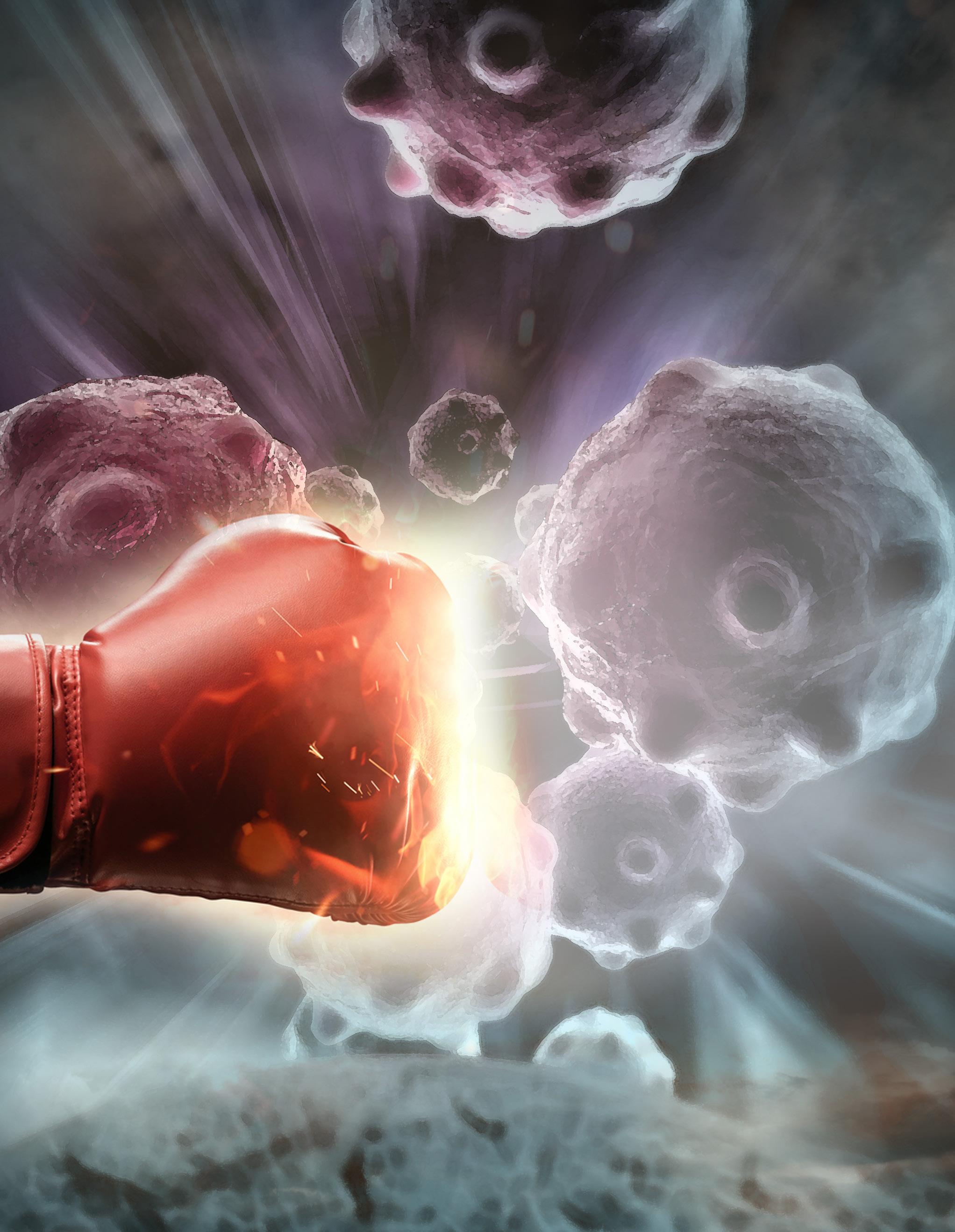
Instead, adaptive therapy aims “to shrink the tumor size, but leave enough sensitive cells that they keep the resistance cells ‘in check,’” she explained.
TEXT WRITTEN BY Laura Mize“Firstline therapy includes surgical resection followed by platinum-based chemotherapeutics,

Defeating a formidable opponent is always a group effort.
UNDERSTANDING IMMUNOTHERAPIES
Another UF biomedical engineer creating models of the tumor microenvironment is Walter Lee Murfee, Ph.D. , an associate professor and the department’s associate chair for undergraduate studies. He leads the Microvascular Dynamics Laboratory.

cells surrounded by blood and lymphatic vessels and immune system cells.

CELLS DESIGNED TO KILL
THE
“The overall goal of our work is to develop novel experimental model platforms that enable investigation of cancer cells, blood vessels, lymphatic vessels and immune cells at the same time,” Murfee said.
Murfee envisions the model as a “lab-on-a-chip” that could easily be used by cancer researchers.
While Sharma and Murfee work on living models, other UF researchers are creating computational models.
which circulating lymphocytes (a type of immune cell) are exposed during external beam radiotherapy. The reference organ and blood vessel models produced at UF can be reshaped to match each patient’s unique organ anatomy as captured through imaging.
Following radiotherapy, some patients have abnormally low lymphocyte counts. MGH physicians have noted that these people have poorer longterm outcomes than patients with normal lymphocyte counts. Because of this, the researchers propose that these vulnerable immune cells should be labeled ”organs-at-risk.”
Sharma Lab: Cancer and natural killer cells interacting in 3D.
Blanka Sharma, Ph.D. an associate professor in the department and the Pruitt Family’s Term Fellow, is focused on another immune system weapon: Natural killer cells. They are designed to essentially poison tumor cells, but instead cancer often neutralizes them.

To understand how this happens and how to combat it, Sharma and her research team are “engineering 3-D models of the tumor microenvironment to [analyze] the biochemical and mechanical cues that impact how natural killer cells migrate
into tumors and recognize cancer cells.”
Based on what they find, the team is “developing nanoparticles that are capable of blocking” chemical signals that would otherwise dampen the soldier cells’ ability to home in on and kill their tumor prey.
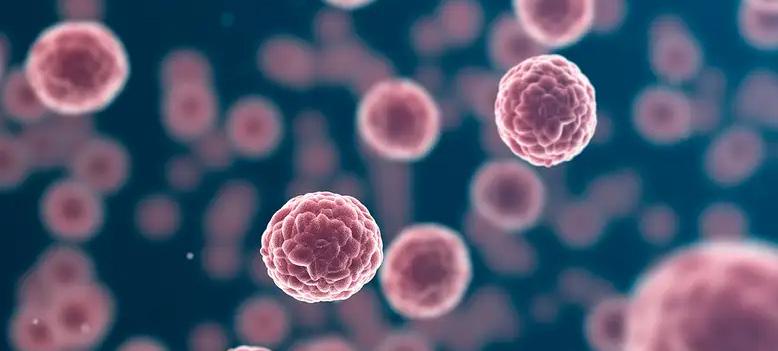
In addition, Sharma collaborates with Rinaldi-Ramos “to establish

clinically viable cell-tracking methods for natural killer cells.”
“The cancer immunotherapy field is progressing very rapidly and there is a lot of excitement around [immunotherapy’s] impact in treating what have been historically very intractable cancer types,” Sharma said. “Natural killer cells are at the forefront of cancer immunotherapies because they could bypass some of the safety and cell-sourcing issues associated with T-cell therapies which are currently in use; this could allow for broader use and lower costs.”
Currently, there is no way to view these all simultaneously, which Murfee calls “a big challenge in the cancer world.”
Overcoming this hurdle would allow scientists to study, for example, the known phenomenon of “tumor cells secreting something, causing lymphatic vessels and blood vessels to remodel.”
They could also examine how tumors respond when the number of attached blood vessels decreases. Big picture goals include discovering new traits of tumors and providing an environment for testing anticancer drugs on human tumor
Wesley Bolch, Ph.D. a distinguished professor and UF term professor, and his team are busy creating computer models of specific organs and tissues so radiation oncologists planning their attack can more accurately and effectively protect cancerfree tissues from radiation toxicity.
They are collaborating with researchers from Massachusetts General Hospital to create a library of computer models of blood and lymphatic vessel networks within organs of virtual adult male and female cancer patients. UF biomedical engineers create the models, which MGH scientists can use to assess the radiation dose to
After approximating how much radiation this patient’s lymphocytes can endure, the radiation oncologists will strategize how to best deliver the right dose.
TEAM IS DEVELOPING NANOPARTICLES THAT ARE CAPABLE OF BLOCKING CHEMICAL SIGNALS THAT WOULD OTHERWISE DAMPEN THE SOLDIER CELLS’ ABILITY TO HOME IN ON AND KILL THEIR TUMOR PREY.Blanka Sharma, Ph.D. Associate Professor & J. Crayton Pruitt Family Professor Nanomedicine, stem cells, biomaterials, tissue engineering, and targeted drug/gene delivery
“THE OVERALL GOAL OF OUR WORK IS TO DEVELOP NOVEL EXPERIMENTAL MODEL PLATFORMS THAT ENABLE INVESTIGATION OF CANCER CELLS, BLOOD VESSELS, LYMPHATIC VESSELS AND IMMUNE CELLS AT THE SAME TIME.”
Walter Lee MurfeeWalter Lee Murfee, Ph.D. Associate Professor & Associate Chair for Undergraduate Studies Cell dynamics, microcirculation, angiogenesis, lymphangiogenesis and neurogenesis Wesley Bolch, Ph.D. Distinguished Professor & UF Term Professor Dosimetry, computational medical physics and dose assessment
“Can we deliver fewer radiation treatments, each with a higher dose? Are there better angles for the radiation beam so we can avoid the major blood vessels feeding the organ? Our tools will eventually allow physicians to redesign the external beam radiotherapies to minimize the dose to the circulating blood cells,” Bolch explained.
In a similar collaboration with Johns Hopkins University, Bolch and his team are working to create models of other organs-at-risk, such as the salivary and lacrimal glands, liver, bone marrow and kidneys. The team uses finely detailed histology images provided by John Aris, Ph.D., from the UF College of Medicine’s Department of Anatomy and Cell Biology


to create the comprehensive models.
These models will help to improve radiopharmaceutical therapy, which Bolch described as “a pharmaceutical chemically linked to a radioactive atom which then decays, emitting charged particles.”

This compound is designed to follow biochemical signals from the tumor, taking the radiation straight to even the tiniest tumors. In a patient with advanced cancer, there
might be hundreds of such tumors. Because this therapy typically is administered intravenously into the blood stream, the radiation can also accumulate at lower levels in some tumor-free tissues. As with the external radiation used for the glioblastoma patients, the physician must determine a dose that will be effective against the tumor but safe for the organs-at-risk. Eventually, these models can be used in human clinical trials.
TRACKING THE ATTACK
Pairing magnetic nanoparticles with immune cells makes them trackable via magnetic imaging. Then, scans reveal where the loaded immune cells travel and give clues to how well the immune system is ramping up to fight the tumor cells.

Carlos Rinaldi-Ramos, Ph.D. , the Dean’s Leadership Professor and chair of the Department of Chemical Engineering; and Jon Dobson, Ph.D. , the Department of Biomedical Engineering’s J. Crayton Pruitt Family Professor are both working to attach various types of nanoparticles to immune cells, then track the migration of these cells via magnetic imaging methods. Modifying immune cells to battle cancer is called immunotherapy.
One of Dobson’s projects in this area focuses on dendritic cells from mice that have a central nervous system cancer called glioblastoma. A dendritic cell “boosts immune responses by showing antigens on its surface to other cells of the immune system,” according to the National Cancer Institute. This makes dendritic cells a
key component of immune system response to vaccines.
After creating “multifunctional RNA-loaded magnetic liposomes,” the scientists vaccinate the mice with them. The RNA in the nanoparticles is from the tumors and meant to provoke an immune system response against the cancer.

Dendritic cells pick up these nanoparticles and, ideally, carry them to the lymph nodes. Two days following vaccination, magnetic resonance imaging shows how many of the nanoparticles the dendritic cells have carried to the lymph nodes.
Rinaldi-Ramos collaborates with Duane Mitchell, M.D., Ph.D., the Phyllis Kottler Friedman Professor in the UF College of Medicine’s Department of Neurosurgery to modify and track immune cells called antigen-specific T cells. These are one of several types of T cells that scientists are working to enhance for battling cancer. After the T cells have been modified, the researchers load them with a superparamagnetic iron oxide nanoparticle, or SPION, to allow for tracking.
One advantage of SPIONs is that they tend to allow for clearer images than other types of nanoparticles.
Tracking movement of modified T cells and post-vaccine dendritic cells is important primarily for previewing immunotherapy effectiveness.
In Dobson’s work, accumulation in lymph nodes of the dendritic cells bearing the magnetic liposome allowed the scientists to predict which of the mice models would respond most positively to the vaccine. The group with the greatest
accumulation two days after injection saw significant tumor shrinkage and survived the longest after vaccination.
The researchers believe the same would be true for humans receiving a cancer vaccine containing magnetic nanoparticles.
“This has significant implications … as it has the potential to allow clinicians to make a very early determination of the efficacy of the immunotherapy,” Dobson explained, “and to adjust the therapeutic regimen accordingly.”
A similar principle seems to be true for T cells.
“There’s some evidence in the literature that suggests that if the T cells get into a tumor within 24 to 48 hours, there’s going to be a positive outcome,” Rinaldi-Ramos explained. “Okay. But we don’t have a good way to do that in humans, to noninvasively track whether they [the T cells] get there.”
That’s where SPIONs and an innovative, still-emerging method known as magnetic particle imaging come in. Though MPI is not yet widely used, its advantage lies in its ability to produce 3-D images clear of “background noise” from surrounding tissues.
As with the dendritic cells in the lymph nodes, if imaging shows inadequate accumulation of the T cells in the tumor, the oncology team can quickly pivot the patient to another treatment strategy.


Pushing Toward Victory
CANCER IS A FORMIDABLE ENEMY.
With UF biomedical engineers and their collaborators innovating novel strategies and creating new tools for the fight, more patients may be closer to earning their victories.
“For many cancers, waiting weeks is a matter of life and death. Being able to determine whether the therapy is effective early on will be extremely valuable.”
EXTERNAL ADVISORY BOARD MEMBERS:
Jenny Amos, Ph.D.

Teaching Professor and Laura Hahn Faculty Fellow,Department of Bioengineering, University of Illinois Urbana-Champaign




Jose Fernandez
Director of Program Delivery, Strategic Client Partnerships, Veranex
William Hogan, M.D.

Professor, Health Outcomes & Biomedical Informatics
College of Medicine, University of Florida
Sarah Mayes, Ph.D.


Co-Founder and Chief Scientific Officer, Alafair Biosciences

Professor and Vice Dean of Research and Graduate Education, University of Washington School of Medicine
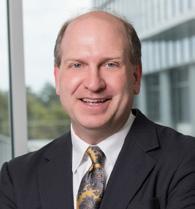
Jerry Chang Board Chair Managing Partner and COO, Samaritan Biologics

Andrés García, Ph.D.
Regents’ Professor, Woodruff School of Mechanical Engineering, Georgia Institute of Technology
Ivan Howard, M.B.A. Director of Hedge Funds and Liquid Alternatives, Banco Santander




Gary Miller
Co-Founder and Executive Vice-President Research and Development (Emeritus), Exactech

Vice President, Research and Development, Axogen, Inc.
Lola Eniola-Adefeso, Ph.D.


University Diversity and Social Transformation Professor of Chemical Engineering and Biomedical Engineering, University of Michigan


Anthony Guiseppi-Elie, Sc.D.




Vice President of Academic Affairs and Workforce Development, Tri-County Technical College


Elizabeth Loboa, Ph.D.

Professor and Provost Department of Mechanical Engineering, Southern Methodist University
Tirth Patel
General Manager, KLS Martin Manufacturing
INSPIRING HOPE AT UF
Anton Svirskyi, a Ukrainian diver and biomedical engineering student who inspires hope in those around him.
>>> ANTON SVIRSKYI has not let the devastation and war experienced by his friends and family in Ukraine deter him from accomplishing his dreams. They have made him all the more determined to persevere.
Since February, Svirskyi has volunteered nearly 1,000 hours of his time providing humanitarian aid to Ukraine while undergoing the NCAA Swimming & Diving Championships and serving as treasurer of the Ukraine Club.

In April, Svirskyi partnered with the University Athletic Association, the Otis Hawkins Center, and other university members to host a donation drive for Ukrainians in need.
In three weeks, they collected 15,000 pounds of supplies such as food, clothes, and first aid.
When asked what helped him through such difficult times, he mentioned diving, math, and his support system as important factors.
Due to the contributions of BME staff, Candi Crimmins, Kelly Stalter, and others, he has found a support system in UF’s Biomedical Engineering department. According to Svirskyi, they support him emotionally and assist with donation drives.



Svirskyi is grateful for the opportunities he has been given to speak about his experiences and shine a light on people in the background.
Nathan Tenzer
Vice President of Operations for Transcatheter Mitral and Tricuspid Technologies, Edwards Lifescience


Marjolein van der Meulen, Ph.D. James M. and Marsha McCormick Director & Swanson Professor Department of Biomedical Engineering, Cornell University
ALUMNI ADVISORY BOARD MEMBERS:
The
Alongside his commitments to volunteering and athletics, Svirskyi is unrelenting in pursuing a bachelor’s degree in biomedical engineering - a field that bridges the gap between technology and modern medicine. With this degree, he wants to find a solution to degenerative vision loss, a condition he has personally witnessed in his family.
Next year, Svirskyi hopes to find the time to research degenerative vision loss in the lab. If he enjoys this aspect of the field, Svirskyi will pursue his Ph.D. in Biomedical Engineering.
Among those and many other aspirations, Svirskyi hopes to join the Olympics after he graduates in 2024. If he decides to pursue his Ph.D., he wants to stay at UF.
“UF is on a different level - a higher level,” he smiled. “When you hear about this school, you know that everything we do comes from a place of integrity.”
Overall, what drives Svirskyi is the opportunity to maximize his potential in facing adversity. “Sometimes you don’t always get the best conditions to do certain things…There isn’t a level playing field.”
Svirskyi struggled with this when he first moved from Ukraine to America.
“There were fewer opportunities, and I learned to work with what I had. Even though it was rough, all the hardship was worth what I had found here. Because of everything I’ve been through, I want to use my platform to help people and do good in the world.”
I couldn’t have done this without the support of the department, university, athletic association, coaches, trainers…everyone. From the bottom of my heart, thank you.
our board members ensure the success of our department
Congratulations to UF BME students Marion Hagstrom and Parker Kotlarz for being selected to represent UF at the National Posters on the Hill event sponsored by the National Council on Undergraduate Research (CUR). These students were selected in a competitive process open to undergraduate researchers from across the country.
This prestigious event celebrates the impressive work of the accepted students and supports the messages of the importance of undergraduate research at the federal level.
“Parker and got to talk with Paul Bonicelli, the Senior Policy Advisor for Sen. Rick Scott. We spoke to him about supporting biomedical research for undergraduates and specifically research for Alzheimer’s disease. Afterward, we joined a zoom of about 120 people for the Posters on the Hill presentations. We split into breakout rooms and showcased our research to attendees,” said Marion.
Posters on the Hill is a critical element in CUR’s advocacy efforts. It is more important than ever that the voice of undergraduate researchers and their mentors is heard on Capitol Hill.

“It was exciting to present our research on a national stage and highlight the continued need to support undergraduate research. Additionally, we were also recognized by IEEE-USA for their Excellence in Engineering Award which truly rewarded us for our work in finding a biomarker for Alzheimer’s disease,” said Parker.
The DEI awards recognize alumni, students, and university employees who champion diversity, equity, inclusion-related issues, and social justice efforts in their communities, industries, and on campus.
19
• Six UF BME students selected for 2022 National Science Foundation (NSF) Graduate Research Fellowships (Angel Bu, Carlos G. Colon-Ortiz, Suzanne Lightsey, Tran Ngo, Aymee Rodriguez and Nicole Sarna)


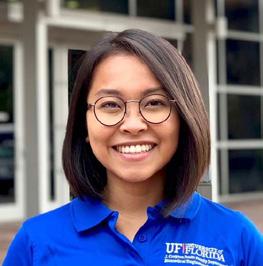
• Two UF BME students selected for Attributes of a Gator Engineer AwardIntegrity, BS: Brianna Pawlyshyn and Professional Excellence, BS: Parker Kotlarz
• Eleven UF BME undergraduate students selected for 2022 University Scholars Program (Abdul-Vehab Dozi, Lauren Ellis, Jean-Pierre Pieratoni, Tanmayee Kolli, Andrea McPherson, Juan Martinez, Robert Ovalle, Tryanni Chiaravalloti, Zaid Abu-Mowis, Michael Olagbiyan and Marion Hagstrom)
• Two UF BME teams selected as finalists for the BMES Student Design Competition, Team Fast and Fusion: Ramya Saldanha, Armoney Emmanuel, Zachary Jordan, Saumya Kapoor, Kimia Mahboub and Sara Thorsness and Game of Stones: Matthew Blackton, Joshua Burgos, Patrick Costello, Amberlyn Hauck, Saiyuri Naidu, Rachael Neary and Danelle Smith
• BME team finalist in the Rice 360 Design Competition People’s Choice Category: Parker Kotlarz, Anthony Gruber, Peyton Warp, Nisha Kotta, Caleb Walton, Isabel Rivera, Angelica Almeida, Olga Chendighelean
• Robert Accolla awarded Best Graduate Oral Presentation, Taylor Lansberry & Brandon Parks awarded Best Graduate Poster Presentations at 2021 UF BME Pruitt Research Day
• Isadora Braga, Garrett Fullerton, Leeor Hershkovich and Natalie Thurlow received Outstanding Undergraduate Research Award at BME Undergraduate Research Day
• Markia Bowe received UF BME Graduate Student Award of Excellence
• Adriana Del Pino Herrera and Skylar Stolte, selected for lightening talk presentations at the Fall 2022 HiPerGator Symposium
• Adriana Del Pino Herrera received 2022 Certificate of Outstanding Achievement from the UF International Center

• Marion Hagstrom and teammates won Yale School of Public Health Global Prize
• Mollie Huber awarded Alpco’s Summer 2021 Diabetes Research Travel Grant





• Parker Kotlarz selected as HWCOE 2022 Commencement Speaker

• Arinola Lampejo received a Microcirculatory Society Zweifach Student Travel Award and presented an oral presentation of the Annual Microcirculatory Society Meeting

• Charles Lazimi received the Human Islet Research Network (HIRN) 2021 Trainee Scholarship

• Renjie Liu, Ph.D., awarded UF BME Postdoc Excellence Award
• Peng Lui received Best Abstract Award at the Montreal AI Neuroscience Conference
• Janny Piñeiro Llanes received UF BME Supervised Teaching Award of Excellence

• Julie Mallinger and teammates earned silver medal for the iGEM competition
• Leyda Marrero Morales and Parker Kotlarz received UF BME UG Student
of Excellence
• Natalie Richer won second place in the 2022 International Brain Products Award competition, recognizing
•
•
• Syed
BME students selected to represent UF at National Posters on the Hill EventERika PLINer, PH.D Ferris Lab Eleana Manousiouthakis, Ph.D. Schmidt Lab TAMARA Ordonez DIAZ NICHOLS Lab Awarded NIH
Welcoming, Dr. Xiao Fan
Fan will unravel rare genetic disorders using
We are excited to welcome Dr. Xiao Fan to the J. Crayton Pruitt Family Department of Biomedical Engineering as an assistant professor in January 2023.
Fan received her Ph.D. in electrical and computer engineering from the University of Alberta in 2016 and her bachelor’s in electronic information science and technology from the Ocean University of China.
Before joining the department, Fan worked at Columbia University as an associate research scientist in the labs of Drs. Wendy Chung and Yufeng Shen. Before that, she was a postdoctoral fellow in the cardiovascular department at the Mayo Clinic in the lab of Dr. Iftikhar Kullo.
Fan’s research seeks to improve the understanding of genetic, biological and medical questions using computational approaches and artificial intelligence (AI). The research projects include the study of rare genetic diseases, interpretation of genetic variants, and characteristics of medical phenotypes. Her laboratory will focus on discovery of novel genes underlying diseases using case-control association studies, identification of pathogenic variants using machine learning methods, and trajectory prediction of medical phenotypes based on cellular, molecular and genetic data.
Fan is the recipient of the K99/R00 Pathway to Independence Award, 2021-2026, Andrew Stewart Memorial Graduate Award, 2015, and the Alberta Innovates Graduate Student Scholarship, 2014-2015.
AI
XIAO FAN, PH.D. ASSISTANT PROFESSOR
Computational approaches to study genetic architecture of rare diseases and interpretation of genetic variants

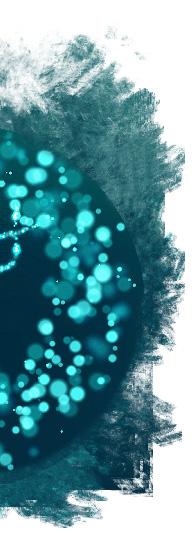
New Clinical Immersion Program
the gap between classroom and fieldwork - enriching the undergraduate learning experience
A team of 7 faculty members at the University of Florida have received an NIH R25 grant to fund a clinical immersion experience for biomedical engineering students.

The directors of this program are Drs. Walter Lee Murfee and Eric Fuller. Fuller is an instructional assistant professor of Biomedical Engineering, a founding member of the BIG-IDEA Biomedical Design Education Team and creator of an International Internship Program for students. Murfee is an associate professor of Biomedical Engineering, associate chair for UG studies, ABET Coordinator, and the recipient of four Teacher of The Year awards.
Murfee and Fuller aim to bridge the gap between classroom learning and fieldwork for students in biomedical engineering. They noticed that the curriculum lacked clinical design problem solving and peer-to-peer instruction, two elements that could take students’ learning experience to the next level.
“We want to improve the undergraduate learning experience by infusing real-world clinical problems throughout the curriculum,” Murfee explained. “That’s the goal.”
Their interdisciplinary summer clinical immersion program will house approximately ten students over the course of ten weeks. During this time, students will be able to work side-by-side with clinicians and identify clinical problems.
The grant funds a senior design class for engineering with a senior capstone project encompassing two semesters. The funds also allow students to develop the prototypes they need to solve clinical problems.
According to Murfee, another metric of success is having students in the program who can teach the material and its application to their freshman or sophomore peers.
“This experience will get them to think about the information in a new way. Young students crave application in the real-world context...the challenge is how to infuse those things into the curriculum,” he said. “By the end of the program, they should be able to solve open-ended problems on their own -problems that may not have clear solutions.”
Murfee and Fuller’s team of program faculty hope that the clinical immersion experience will build an even stronger foundation of skills and knowledge for their biomedical engineering students.
“We want to improve the undergraduate learning experience by infusing real-world clinical problems throughout the curriculum,” Murfee explained.
“ “

Learning Assistants Impact Undergraduate Teaching
Q&A with Dr. May Mansy
What are the LA program goals?
• Develop new learning techniques.
• Acquire the art of questioning.
• Understand the neurological aspects of learning.
Utilize metacognitive skills to elicit cognitive engagement.
• Identify implicit bias inside and outside the classroom.
What is the Learning Assistant (LA) Program?
The LA program is a collaborative learning strategy that trains UG frontrunners to assist the next cohort of students in learning course content. The program enhances students’ learning experiences by making courses more interactive and inclusive and making large classes feel more like small ones. There are only two formal LA programs at UF (Physics and Biology) and the BME-LA program is the first LA program in the Herbert Wertheim College of Engineering.
What is the LA model?
Undergraduate students who, through the guidance of weekly preparation sessions with faculty and a training program, facilitate small-group activities in a variety of classroom settings to support student learning and success. The LA model has been demonstrated to increase students’ engagement, learning, performance, and confidence in the course.
How are LAs selected?
We have a thorough application process for students, who apply by invitation only; this is followed by interviews with faculty.
How are LAs prepared and supported?
LAs participate in 1 to 1.5-hour weekly preparation sessions led by the instructor(s) of the course in which they are serving as an LA. In these sessions, the group reviews the week ahead, discussing challenging concepts, developing and engaging in upcoming lecture activities, and reflecting on student learning.
How are LAs different than UAs/UTAs (undergraduate teaching assistants)?
LAs receive pedagogical training, which sets them apart from UTAs, and even many graduate teaching fellows. Research here at UF BME and at other institutions has shown that LAs are much more effective at guiding students, especially in small group learning environments.
“ “
FACULTY/STAFF AWARDS AND RECOGNITIONS
• Ismael Arroyo (Engineer II & Teaching Specialist), HWCOE 2022 Staff Award for Innovation
• Dr. Ruogu Fang, HWCOE Faculty Award for Excellence in Innovation & UF BME Faculty Research Excellence Award

• Dr. Sarah Furtney, HWCOE Undergraduate Teacher of the Year Award
• Dr. Meghan Ferrall-Fairbanks, CTSI KL2 Award
• Dr. Aysegul Gunduz, inaugural UF DEI Leadership Award
• Dr. May Mansy, UF BME Faculty Teaching Excellence Award
• Drs. Ivana Parker and Ana Maria Porras, Global Fellows from the UF International Center and accepted to 2022 Career MODE Program

• Dr. Edward Phelps, UF BME Service Excellence Award
• Dr. Ana Maria Porras featured in Smithsonian Exhibit
• Dr. Parisa Rashidi, HWCOE Faculty Awards for Excellence in Leadership
• Drs. Carlos Rinaldi-Ramos and Cherie Stabler, HWCOE Doctoral Dissertation Advisor/Mentoring Awards
• Dr. Brittany Taylor accepted to Training in Grantsmanship for Rehabilitation Research (TIGRR) Workshop


FACULTY PROFESSIONAL LEADERSHIP AND PROMINENT SERVICE POSITIONS
• Dr. Kyle Allen standing member and Vice Chair for NIH Skeletal Biology, Structure, and Regeneration Study Section and appointed Associate Editor for Osteoarthritis and Cartilage

• Dr. Ruogu Fang appointed Topic Editor on “Women In Brain Imaging and Stimulation” with Frontiers in Human Neuroscience Journal
• Dr. Lee Murfee served as President of AEMB Biomedical Engineering Student International Honors Society, Past President of The Microcirculatory Society & appointed Associate Editor for Frontiers in Physiology – Cell Physiology

• Dr. Ana Maria Porras served on Editorial Board of GEN Biotechnology
• Dr. Parisa Rashidi appointed founding co-director of the Intelligent Critical Care Center (IC3)

• Dr. Cherie Stabler appointed Associate Editor of Journal of Tissue Engineering and Regenerative Medicine

• Dr. Lakiesha Williams appointed Chair for Finance and Arrangements at Summer Biomechanics, Bioengineering, and Biotransport (SB3C) Conference
• Dr. Gregory Hudalla edited the Special Issue of Advanced Healthcare Materials, “Medical Applications of Glycomaterials” published in Feb. 2022
• Dr. Lakiesha Williams invited to serve on Editorial Board of Current Opinion in Biomedical Engineering Journal
RESEARCH ACTIVITIES & NEW MAJOR GRANTS
• Dr. Kyle Allen received NIH R01, “Treatment of Knee Osteoarthritis via Intra-articular Delivery of an Immuno-suppressive Enzyme” for $2.2M
• Dr. Wesley Bolch received DoD award, “Aligning Dosimetry and Biomarkers of Lung Injury with Prophylaxis and Mitigation of Damage from Radionuclides and Metals” for $1.5M
• Dr. Wesley Bolch received NIH P01, “Multi-Scale Evaluation and Mitigation of Toxicities Following Internal Radionuclide Contamination” for $1.9M
• Dr. Ruogu Fang received NIH NIAAA U24 grant, “Southern HIV and Alcohol Research Consortium Biomedical Data Repository” for $2.5M
• Dr. Ruogu Fang received NIH NIAAA P01 grant, “Interventions to Improve Alcohol-related Comorbidities Along the Gut-brain Axis in Persons with HIV infection” for $6.6M
• Dr. Ruogu Fang received NSF SCH grant, “Collaborative Research: SCH: Trustworthy and Explainable AI for Neurodegenerative Diseases” for $1.2M
• Dr. Ruogu Fang received NIH NIAAA P01 grant, “SHARE Program: Innovations in Translational Behavioral Science to Improve Self-management of HIV and Alcohol Reaching Emerging adults” for $1.5M
• Dr. Mingzhou Ding received NIH NIMH R01, “Acquisition, Extinction, and Recall of Attention Biases to Threat: Computational Modeling and Multimodal Brain Imaging” for $2.3M
• Dr. Aysegul Gunduz received NIH NINDS grant, “Defining Targets for Tic Detection and Suppression in Tourette Syndrome Deep Brain Stimulation” for $3M
• Dr. Ben Keselowsky received NIH R01, “Directing Tryptophan Immunometabolism to Ameliorate Liver Ischemic-Reperfusion Injury” for $2.3M
• Dr. Ben Keselowsky received NIH NIDDK T32, “Interdisciplinary Graduate Program in Type 1 Diabetes and Biomedical Engineering” for $1.75M
• Dr. Jennifer Nichols received NIH NIAMS R01, “Carpometacarpal Osteoarthritis: Under standing the Intersection of Muscle Mechanics, Joint Instability, and Pain” for $2.2M
• Dr. Edward Phelps received NIH R01, “Local Immune Modulation for Beta Cell Replacement Therapy in Type 1 Diabetes” for $1.96M
• Dr. Parisa Rashidi received NIH NIBIB R01, “Intelligent Intensive Care Unit (I2CU): Pervasive Sensing and Artificial Intelligence for Augmented Clinical Decision-making” for $2.M
• Dr. Parisa Rashidi received NIH NINDS R01, “ADAPT: Autonomous Delirium Monitoring and Adaptive” for $2.M
• Dr. Carlos M. Rinaldi-Ramos received NIH R01 “Nanoparticles to Track T cell
using Magnetic Particle Imaging” for $1.8M

“This semester’s pedagogy course has been an invaluable learning opportunity for me. I feel much more informed on how to approach teaching and interacting with students and I’ll be able to use the various techniques and skills I learned in my future career.”
- Cassidy Nordmann
Kyle D. Allen
Associate Professor Ph.D., Rice University
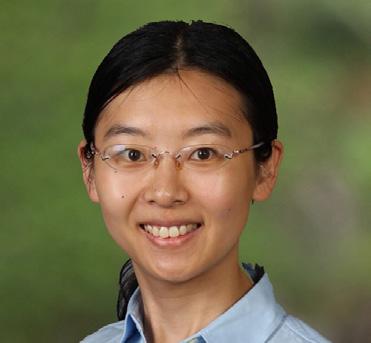

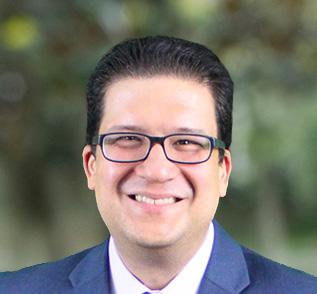


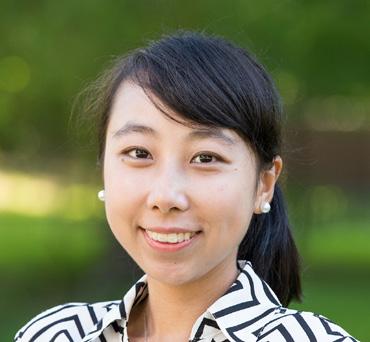




Novel strategies to diagnose and treat degenerative joint diseases
Wesley E. Bolch
Distinguished Professor & UF Term Professor Ph.D., University of Florida
Dosimetry, computational medical physics and dose assessment
Mingzhou Ding
Distinguished Professor & J. Crayton Pruitt Family Professor Ph.D., University of Maryland
Cognitive neuroscience, signal processing and neural imaging
Jon P. Dobson

J. Crayton Pruitt Family Professor Ph.D., Swiss Federal Institute of Technology, ETH-Zurich


Magnetic micro- and nanoparticle-based biomedical applications
Ruogu Fang
Associate Professor Ph.D., Cornell University

Artificial intelligence, brain dynamics and medical image analysis
Eric Fuller
Instructional Assistant Professor Ph.D., University of Florida
Engineering design and engineering education
Sarah Furtney
Instructional Assistant Professor & Undergraduate Coordinator Ph.D., Clemson University


BME cellular engineering laboratory and engineering education research
Associate Professor, UF Research Foundation Professor & UF Term Professor Ph.D., University of Florida
Human brain mapping, neuromodulation and neural interfacing
Gregory A. Hudalla
Associate Professor & Graduate Coordinator Ph.D., University of Wisconsin

Molecular engineering for immunotherapies and immune
Benjamin G. Keselowsky
Professor & Associate Chair for Graduate Studies Ph.D., Georgia Institute of Technology
Biomaterials and controlled release systems for vaccines, immunotherapies and implants
Jamal Lewis
Associate Professor Ph.D., University of Florida

Biomaterials, drug delivery, and immunoengineering
May Mansy
Assistant Professor Ph.D., Georgia Institute of Technology







Quantitative systems biology, mathematical modeling, cancer heterogeneity and evolutionary dynamics
Robert W. Adenbaum Professor Ph.D., University of California, Berkeley

Biomechanics, neuromechanical control, locomotion, mobile brain imaging, robotic exoskeletons and bionic prostheses
Instructional Assistant Professor Ph.D., University of Florida

Bio-signals & systems, bio instrumentation lab and engineering education
Peter S. McFetridge
Associate Professor Ph.D., University of Bath


Naturally inspired biomaterials for biologically functional implants and organ regeneration
Cell
Biomaterials
Biomaterials for neural tissue regeneration and neural interfacing
Nanomedicine, biomaterials, targeted drug/gene delivery and immunoengineering
Cherie Stabler
Professor, Integra LifeSciences Term Professor & UF Foundation Preeminence Term Professor Ph.D., Georgia Institute of Technology
Biomaterials, controlled release, regenerative medicine and diabetes
Musculoskeletal tissue engineering, bioactive biomaterials, tendon injury and repair
Traumatic
BME Community Outreach Fund

five collaborative research projects awarded in 2022
Arthrex is a global leader in orthopedic surgical device design, research, manufacturing, and medical education. Arthrex’s corporate headquarters is located in Naples, Florida, where visitors will find a vibrant atmosphere of rapid product innovation, medical research and surgeon collaboration. The sprawling campus houses corporate and manufacturing operations and Arthrex’s premier Medical Education Center.


Dr. Ana Maria Porras: Science Communication Training Program



A program in Spanish with complimentary virtual and in-person public engagement opportunities in which Spanish-speaking UF students engage with
Dr. Meghan Ferrall-Fairbanks: Cancer Biology Bootcamp






A two-day hands-on bootcamp designed to introduce middle school students from rural schools to molecular biology tools and their applications in cancer research.


Dr.

Interactive STEM Modules
Middle school and high school outreach modules highlighting BME, targeted to low-socio-economic schools.
Drs. Kyle




STEAM Camp Biomedical Engineering Day
Diversify the orthopaedic field by providing research exposure and personalized mentoring to K-12 youth and undergrads from under-represented backgrounds through the UF Ortho Scholars Program (UF-OSP).

1275 Center Drive, P.O. Box 116131
Gainesville, FL 32611-6131

 Herbert Wertheim College of Engineering J. Crayton Pruitt Family Department of Biomedical Engineering at the University of Florida Biomedical Sciences Building JG56
Herbert Wertheim College of Engineering J. Crayton Pruitt Family Department of Biomedical Engineering at the University of Florida Biomedical Sciences Building JG56
